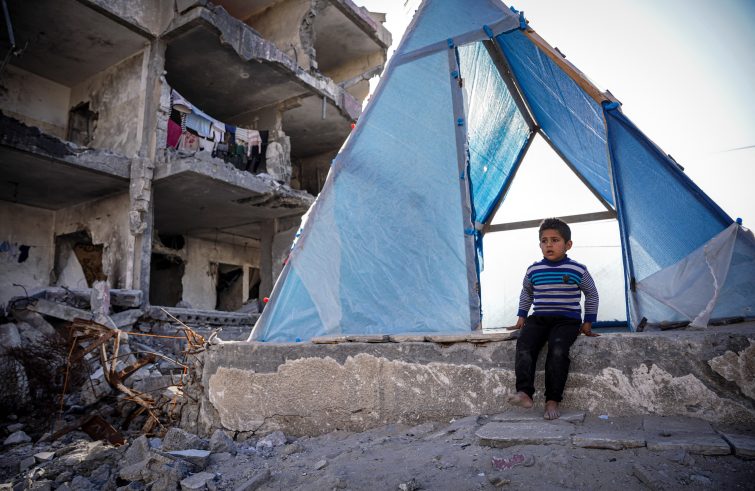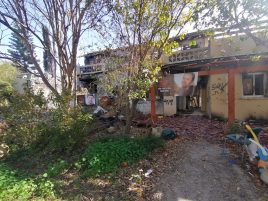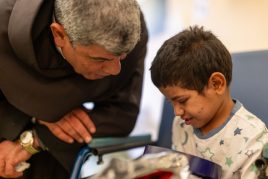
Six months have passed since that tragic 7 October: 180 long, seemingly endless days of unimaginable suffering in the Holy Land. From the very first days, we realised that violence and hatred had reached painful, and unbearably vengeful proportions. The fact that war could so ruthlessly bring to an abrupt end the ongoing efforts to promote peaceful coexistence among people and to educate new generations for peace was certainly beyond anyone’s predictions.
 Responding to evil with prayer. The days of prayer and liturgy in the Holy Land over the past six months have been the most powerful and compelling. The number of dead and wounded has risen sharply since the first month of the war. We held a memorial service for all the dead, including those killed in the war, on 2 November. We did not want to be a part of this madness. We prayed for those who were still under the rubble and for those who had died in the streets without rescue, alone and without burial. The sombre atmosphere continued throughout Advent, a time of spiritual strength that nurtured feelings of hope for the local Christians, especially those in Bethlehem left jobless by the lack of pilgrims and without hope for the future of their children. The coming of Christmas was not experienced in the same way as in previous years, when, in spite of the difficult socio-political situation, the joy of the coming of Jesus, the Prince of Peace, was experienced with greater serenity. We were unable to experience the full joy of the coming of our Saviour because of scenes of death, devastation of homes, hospitals, schools, churches and mosques, and the lack of a safe haven in Gaza. The celebration of Holy Night saw the Bethlehemites gathered in prayer in St Catherine’s Church, which in previous years had been packed with pilgrims from all over the world. I can still recall the sombre faces and gazes of the local Christians as they prayed in heartfelt expectation of the peace they longed for.
Responding to evil with prayer. The days of prayer and liturgy in the Holy Land over the past six months have been the most powerful and compelling. The number of dead and wounded has risen sharply since the first month of the war. We held a memorial service for all the dead, including those killed in the war, on 2 November. We did not want to be a part of this madness. We prayed for those who were still under the rubble and for those who had died in the streets without rescue, alone and without burial. The sombre atmosphere continued throughout Advent, a time of spiritual strength that nurtured feelings of hope for the local Christians, especially those in Bethlehem left jobless by the lack of pilgrims and without hope for the future of their children. The coming of Christmas was not experienced in the same way as in previous years, when, in spite of the difficult socio-political situation, the joy of the coming of Jesus, the Prince of Peace, was experienced with greater serenity. We were unable to experience the full joy of the coming of our Saviour because of scenes of death, devastation of homes, hospitals, schools, churches and mosques, and the lack of a safe haven in Gaza. The celebration of Holy Night saw the Bethlehemites gathered in prayer in St Catherine’s Church, which in previous years had been packed with pilgrims from all over the world. I can still recall the sombre faces and gazes of the local Christians as they prayed in heartfelt expectation of the peace they longed for.
 Sign of hope. The past six months have been filled with reports, images and figures that we could never have imagined, and even a brief respite could not erase them. The arrival in Italy of 160 people – children, adults and those accompanying them – for treatment in Italian hospitals has been an important sign of hope. I am grateful for the support and generosity of the Italian people. Lent was a time to seek hope in the sorrowful Stations of the Cross, which we set out to follow as a way of peace, to journey in faith and to bring light to the future of our children and young people. On the Way of Sorrows, we prayed for our brothers and sisters in Gaza who suffer from hunger, thirst and a total lack of dignity and respect for life.
Sign of hope. The past six months have been filled with reports, images and figures that we could never have imagined, and even a brief respite could not erase them. The arrival in Italy of 160 people – children, adults and those accompanying them – for treatment in Italian hospitals has been an important sign of hope. I am grateful for the support and generosity of the Italian people. Lent was a time to seek hope in the sorrowful Stations of the Cross, which we set out to follow as a way of peace, to journey in faith and to bring light to the future of our children and young people. On the Way of Sorrows, we prayed for our brothers and sisters in Gaza who suffer from hunger, thirst and a total lack of dignity and respect for life.
We asked to be vigilant, attentive “apostles”, open to others, free from selfishness or mistrust.
Easter celebrations took place at the different pace and at different times in the places where it all happened. Uncertainty and loneliness accompanied the sadness of remembering the Passion and Death of Our Lord. Sometimes the celebrants outnumbered the faithful. We brought the sufferings of the mothers to the foot of the Cross and entrusted them to Our Lady of Sorrows. An empty Jerusalem without pilgrims, with the few local Christians and no Christians from the West Bank, added to the sad images of the devastating war for the Holy Land.
This land is home to people who for too long have experienced the weariness of fear, the sadness of uncertainty, disappointment and lack of confidence.
We remain committed to peace, calling for greater dialogue and responsibility, praying that this war will end once and for all and that the people of God may rediscover hope in their neighbour and in the future.
(*) Vicar of the Custody of the Holy Land












